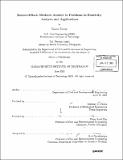Reduced-basis methods applied to problems in elasticity : analysis and applications
Author(s)
Veroy, Karen Paula L. (Karen Paula Lavarro), 1975-
DownloadFull printable version (19.66Mb)
Other Contributors
Massachusetts Institute of Technology. Dept. of Civil and Environmental Engineering.
Advisor
Anthony T. Patera.
Terms of use
Metadata
Show full item recordAbstract
Modern engineering problems require accurate, reliable, and efficient evaluation of quantities of interest, the computation of which often requires solution of a partial differential equation. We present a technique for the prediction of linear-functional outputs of elliptic partial differential equations with affine parameter dependence. The essential components are: (i) rapidly convergent global reduced-basis approximations - projection onto a space WN spanned by solutions of the governing partial differential equation at N selected points in parameter space (Accuracy); (ii) a posteriori error estimation - relaxations of the error-residual equation that provide inexpensive bounds for the error in the outputs of interest (Reliability); and (iii) off-line/on-line computational procedures - methods which decouple the generation and projection stages of the approximation process (Efficiency). The operation count for the on-line stage depends only on N (typically very small) and the parametric complexity of the problem. We present two general approaches for the construction of error bounds: Method I, rigorous a posteriori error estimation procedures which rely critically on the existence of a "bound conditioner" - in essence, an operator preconditioner that (a) satisfies an additional spectral "bound" requirement, and (b) admits the reduced-basis off-line/on-line computational stratagem; and Method II, a posteriori error estimation procedures which rely only on the rapid convergence of the reduced-basis approximation, and provide simple, inexpensive error bounds, albeit at the loss of complete certainty. We illustrate and compare these approaches for several simple test problems in heat conduction, linear elasticity, and (for Method II) elastic stability. (cont.) Finally, we apply our methods to the "static" (at conception) and "adaptive" (in operation) design of a multifunctional microtruss channel structure. We repeatedly and rapidly evaluate bounds for the average deflection, average stress, and buckling load for different parameter values to best achieve the design objectives subject to performance constraints. The output estimates are sharp - due to the rapid convergence of the reduced-basis approximation; the performance constraints are reliably satisfied - due to our a posteriori error estimation procedure; and the computation is essentially real-time - due to the off-line/on-line decomposition.
Description
Thesis (Ph. D.)--Massachusetts Institute of Technology, Dept. of Civil and Environmental Engineering, 2003. Includes bibliographical references (p. 177-180).
Date issued
2003Department
Massachusetts Institute of Technology. Department of Civil and Environmental EngineeringPublisher
Massachusetts Institute of Technology
Keywords
Civil and Environmental Engineering.